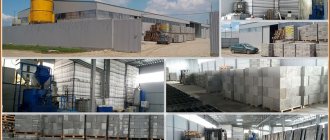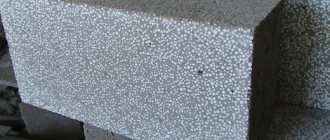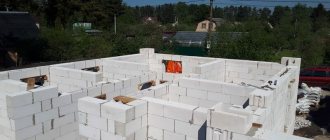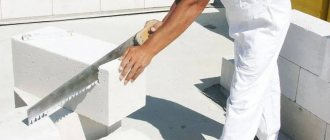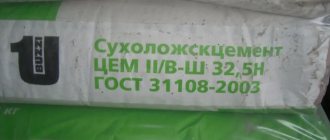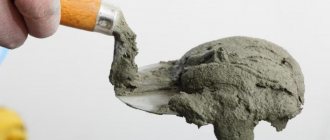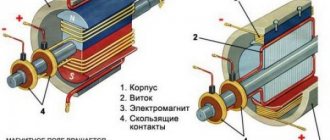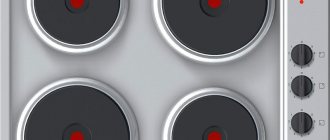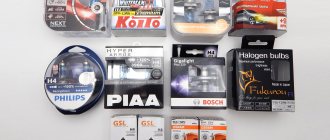Brief conclusions: the use of polystyrene concrete blocks, despite the higher market cost, ultimately results in significant savings in the final construction of the home, due to the lack of insulation, savings on the foundation, savings on heating costs and acceleration of construction work, minimization of breakage and broken blocks during transportation and unloading. And most importantly, the homeowner receives a more comfortable and reliable home.
Now let's take a more detailed look at the characteristics of these two types of building materials from a professional point of view, without any embellishment, based on GOST construction documentation.
Thermal insulation
Let's compare the real thermal conductivity, for our not dry Samara climate, of these two materials. For comparison, let’s take D400 gas silicate and D400 polystyrene concrete. But it is real under conditions B, the so-called wet operating conditions. We look at table A1 in GOST 31359-2007 for gas silicate and see that at 5% humidity D400 gas silicate has a lambda of 0.117 W/(m °C).
We look at GOST 33929-2016 for polystyrene concrete, Table 2, and see that the same brand D400 at 6% humidity has the same exact lambda of 0.117 W/(m °C). That is, polystyrene concrete can hold this lambda up to 6%.
That's why they didn't indicate the remaining humidity levels for gas silicate with this lambda? That would certainly be interesting)
But as you can see, polystyrene concrete, under equal conditions, will be drier and therefore warmer , because the wetter the material, the higher its thermal conductivity. And it turns out that, all other things being equal, polystyrene concrete creates better operating conditions for itself and has lower equilibrium moisture content in this structure than cellular concrete!
The figure shows a comparison of the thickness of walls made of PSB and aerated concrete with the same thermal conductivity and the same density:
In practice, unlike fragile aerated concrete, polystyrene concrete with a density of D400 is sufficient to build load-bearing walls, and then we get the following:
What does this mean? In the Samara region, the walls of cottages are equipped without insulation with aerated concrete 400-450mm wide. And such a wall is equal to polystyrene concrete with a width of only 300 mm. From here we get significant savings on cubic meters of material. Despite the higher market price of PSB, it still turns out cheaper! Not to mention the savings on a lightweight foundation.
Characteristics of polystyrene concrete
The next type of “lightweight” concrete is polystyrene concrete, a universal material that is used at any stage of construction.
It is used not only for the construction of walls, but also for laying floors between floors, separating the basement and attic space. The main distinguishing feature is the presence of a lightweight filler - polystyrene, which gives concrete additional strength, density and thermal insulation.
The composition is quite simple, it includes:
- Portland cement;
- Sand;
- Water;
- Plasticizers;
- Polystyrene granules.
Advantages of polystyrene concrete blocks
Polystyrene concrete is a universal material; experts prefer its use everywhere, as it has a large list of positive properties:
- Reliability – buildings made of polystyrene concrete blocks are durable, not subject to shrinkage, do not deform and withstand environmental influences;
- Lightness - despite their large dimensions, the blocks are light in weight, which significantly reduces the pressure on the foundation of the building;
- Low thermal conductivity - the foam granules included in the form provide the blocks with high thermal insulation;
- Ease of use - the blocks are easy to move and store, they are amenable to additional processing - they can be sawed, drilled, chiseled. The dimensions allow to reduce the time for construction work.
- Noise insulation;
- Resistance to mold and fungal infections;
- Moisture resistance;
- High frost resistance - buildings can withstand up to 100 cycles;
- Possibility of carrying out work at any time of the year.
Disadvantages of polystyrene concrete blocks
Among the negative properties are the following:
- Destruction under the influence of fire - the material belongs to the low-flammability class, it does not burn, but polystyrene granules melt, and this leads to a loss of technical properties;
- Poor adhesion - the blocks are smooth, so they do not hold the decorative coating well without prior preparation (priming).
Frost resistance
The main characteristic of the durability of materials, which is determined by moisture absorption. A characteristic that shows how many freeze-thaw cycles a building material can withstand without losing its physical strength properties, in other words, without collapsing.
For cellular autoclaved concrete, which is aerated concrete, frost is the main enemy, since this material is very fragile. According to GOST 31360-2007, the following is determined for gas silicate:
In other words, the maximum frost resistance of gas silicate cannot be more than 25 cycles, regardless of density!
We look at GOST 33929-2016 for polystyrene concrete Table 1
Even if we do not take into account that densities of polystyrene concrete up to D250 are not used in the external structure of buildings, it is clear how much more durable this material will be. In practice, for load-bearing external walls, polystyrene concrete blocks D400-D500 are used, whose frost resistance is from 150 to 200 cycles, which is almost 8-10 times more than that of aerated concrete blocks. This means that a house made of polystyrene concrete blocks is 8-10 times more durable than a house made of aerated concrete blocks!
Please note that most aerated concrete manufacturers deliberately inflate their performance for advertising purposes, relying on an inexperienced user who does not refer to official state standards.
But why does aerated concrete have such low frost resistance? For two reasons.
Peravya - fragility. The gas silicate cement matrix is a very fragile material in its composition. For the same reason, during the delivery and unloading of gas silicate blocks, a lot of breakage and spalling occurs.
The second reason is water absorption. Unfortunately, state standards do not define this characteristic as a primary property, since they determine the final one - frost resistance. In practice, there are many tests that show the water absorption of aerated concrete from 50 to 80% (for different times)!!! There is also a dependence of the destruction of the material on the degree of wetness; the higher the percentage of water absorption, the greater the degree of destruction will be during the freeze-thaw cycle! This is precisely what affects such a small number of cycles F in GOST for gas silicate.
Polystyrene concrete practically does not absorb moisture, since it inherits this property from expanded polystyrene. The maximum amount of water absorption is from 4 to 6% (for different times and with different densities).
Easy processing of aerated concrete
The large size of the blocks and ease of processing make it possible to erect walls in a short time, significantly saving construction time. The precise geometry, in turn, ensures minimal seams between blocks, reducing cold bridges and the cost of masonry adhesive.
Provides a good microclimate. The pores enable gas exchange, which creates a pleasant indoor climate. It absorbs excess moisture and releases it when the air is too dry, guaranteeing coolness in summer and warmth in winter.
Aerated concrete is a block that is made as a result of the interaction of a mixture of cement, purified quartz sand of the smallest fraction, lime, water and gas-forming additives. Due to the reaction of lime with additives, a huge number of pores appear in the total mass, which affect its properties.
Pros/cons of aerated concrete and polystyrene concrete
As always, we’ll start the list with aerated concrete.
Advantages of aerated concrete:
- does not burn;
- relatively low weight, thereby reducing the load on the foundation;
- easy to process, easy to saw with strings;
- good sound insulation, higher than that of brick;
Disadvantages of aerated concrete:
- Environmentally friendly, contains waste (ash, lime)
- high thermal conductivity, i.e. requires insulation;
- quite fragile;
- very high level of water absorption;
- when the foundation shrinks, there is a high probability of cracks;
- If wall finishing technologies are not followed, the positive properties of aerated concrete can be lost.
Advantages of polystyrene concrete:
- all the advantages of aerated concrete
- very low weight;
- high strength index;
- not afraid of moisture
- the ability to produce large wall panels, which significantly speeds up the speed of wall construction;
- excellent indicator of frost resistance. PSB is capable of withstanding up to 200 cycles of thawing and freezing;
- environmentally friendly, chemically neutral;
- fire resistant;
- very easy to process, easy to saw and groove. It is possible to give any shape to the material;
- resistant to environmental influences;
- possibility to purchase blocks with cladding.
Disadvantages of polystyrene concrete as a material:
- Due to the easy and widespread production, it is possible to come across low-quality material; you need to buy from trusted suppliers.
Below is a comparative table of important characteristics that aerated concrete and polystyrene concrete have.
Comparative characteristics of wall building materials
| Indicators/material | Density, kg/m3 | Thermal conductivity, W/m C | Water absorption % by mass | Wall thickness at R=3.15m | Weight of 1 m3 of wall, kg |
| Solid clay brick | 1700 | 0,81 | 16 | 2,5 | 1950 |
| Brick with voids up to 20% | 1400 | 0,43 | 16 | 1,35 | 1600 |
| Silicate brick | 1800 | 0,87 | 16 | 2,7 | 2160 |
| Cellular concrete (foam concrete) | 500-600 | 0,16-0,19 | 14 | 0,5-0,6 | 550-660 |
| Expanded clay concrete | 500-1200 | 0,23-0,52 | 18 | 0,7-1,6 | 560-1570 |
| Wood | 500 | 0,14-0,18 | 20 | 0,45 | 525 |
| Polystyrene concrete | 250-400 | 0,075-0,10 | 4 | 0,24-0,32 | 550-660 |
Properties of polystyrene concrete
Modern polystyrene concrete is a composite material with low thermal conductivity that provides heat and noise insulation. It includes:
- Portland cement;
- Mineral filler;
- Porous aggregate;
- Air-entraining additive.
Foamed polystyrene granules, characterized by low bulk density, are used as a porous filler in the production of polystyrene concrete.
The composition of the material ensures its basic properties: thermal conductivity, noise insulation, lightness. Manufacturing is carried out in accordance with the requirements of GOST 33929-2016 Polystyrene concrete. Technical conditions.
Comparison of polystyrene concrete with brick
The figure shows a comparative description of a wall made of polystyrene concrete and brick.
- The thickness of the brick wall is at least 45 cm, including insulation; the wall is made of polystyrene concrete blocks only 30 cm thick
- The seam between bricks is from 10 to 12 mm, between polystyrene concrete blocks - 2-4 mm - no “cold bridges” are formed, reducing the cost of masonry mortar.
- The weight of a wall made of polystyrene concrete blocks is 4-6 times less than a brick wall, and this is an additional saving on the foundation
- Due to the fact that the weight of large-sized polystyrene concrete blocks does not exceed 34 kg, the labor intensity and time of wall construction is reduced several times.
- Due to low water absorption, a wall made of polystyrene concrete blocks does not require additional waterproofing, which also affects the final cost of construction
Thus, when comparing bricks with polystyrene concrete, you can notice significant differences in the main parameters that will make your home warm, durable and, most importantly, cost-effective
Important! The insulation becomes unusable over time when exposed to moisture; after 3-10 years it needs to be completely replaced. At the same time, microorganisms and rodents grow in the insulation layer in a humid environment. The insulation is filled between the walls at the time of construction, so its subsequent replacement will be very labor-intensive and expensive.
With the same foundation, due to the smaller thickness of the walls, the number of square meters increases. meters of usable area.
You can buy polystyrene concrete blocks in the Stavropol Territory on KavMinVody SIP KMV ! order polystyrene concrete blocks by calling: +7 ( 928 ) 34-77-125 , +7 ( 87934 ) 7-68-41
Source
Comparison of polystyrene concrete with expanded clay concrete
The figure shows a comparative description of a wall made of polystyrene concrete and expanded clay concrete.
- The thickness of the wall made of expanded clay concrete, including insulation, is 48 cm, the wall made of polystyrene concrete blocks is only 30 cm thick.
- The seam between expanded clay concrete blocks is from 10 to 12 mm, between polystyrene concrete blocks - 2-4 mm - no “cold bridges” are formed, reducing the cost of masonry mortar.
- The weight of the wall is 5 times less than that of a wall made of expanded clay concrete blocks, and this is an additional saving on the foundation.
- Due to the fact that the weight of large-sized polystyrene concrete blocks does not exceed 34 kg, the labor intensity and time of wall construction is reduced several times.
- Due to low water absorption, a wall made of polystyrene concrete blocks does not require additional waterproofing, which also affects the final cost of construction
Thus, when comparing expanded clay concrete with polystyrene concrete, you can notice significant differences in the main parameters, not to mention the excellent quality of the finished polystyrene concrete wall.
Important! The insulation becomes unusable over time when exposed to moisture; after 3-10 years it needs to be completely replaced. At the same time, microorganisms and rodents grow in the insulation layer in a humid environment. The insulation is filled between the walls at the time of construction, so its subsequent replacement will be very time-consuming and expensive
With the same foundation, due to the smaller thickness of the walls, the number of square meters increases. meters of usable area.
